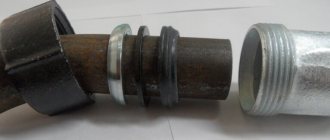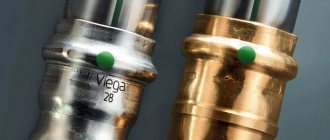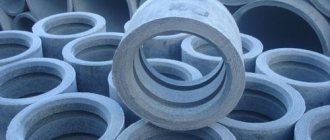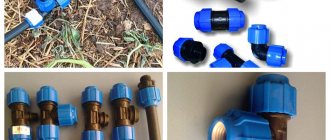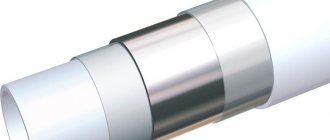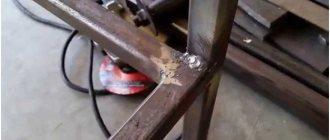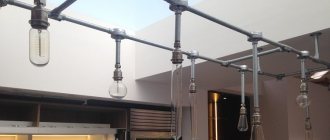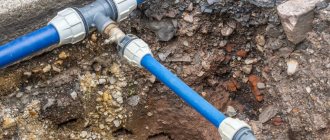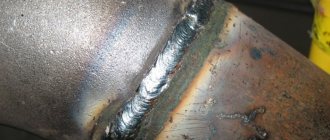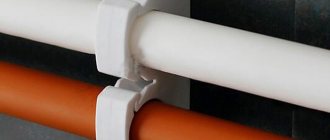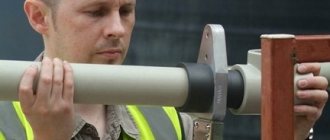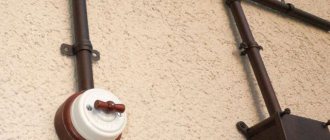When repairing and replacing apartment pipelines, or installing risers, not all connections can be welded. It is impossible to cut threads on a pipe that is close to the wall. For the joint, you will need devices for threadless connection of steel pipes.
Using them, they install main and process pipelines for transporting gas, oil, chemical reagents, and saturated steam. When connecting pipes without welding, the risk of corrosion damage to the joints is eliminated. The metal is protected by tightening linings; they form airtight joints.
Methods for connecting metal pipes without welding
Not all metals are welded well, and sometimes the quality of the seams is poor. Threaded joints are not tight enough, screw threads on metal are destroyed over time.
Weldless connections are technologically advanced. The devices are used on high-pressure gas pipelines when transporting heated media. To install seals, no preliminary preparation of joints or cutting of edges is required. It is enough to clean the ends from dirt and dust.
Methods for connecting metal pipes without welding:
- Clamp tie. A sealed, tight-fitting seal is used to seal leaks. Repairs can be done quickly.
- Flanged. The tightness of the plates is regulated by bolted fasteners, the tightness is ensured by a rubber gasket.
- Installation of the repair mounting clip. The joint is securely fixed in a small metal case.
- Using the Gebo coupling. The compression fitting is suitable for repeated use.
- Fastening fittings without threads. A permanent, hermetic connection of high strength is formed.
- Crab systems. Used for profile rolling.
For threadless connections, no special electrical or gas equipment is required; an installation tool is sufficient. To install the device, no technical training is required.
Connection using fittings
Mounting elements used in pipeline assembly vary in type and scope. Types of fittings:
- straight lines are intended for joining two system elements in the same plane;
- adapters are needed when connecting workpieces of different diameters; they are often necessary when repairing old pipelines;
- rotary, allow you to change the direction of flow;
- end caps are necessary when changing the pipeline layout;
- adjustable (tees, crosses) are needed when inserting into main lines or when installing bends;
- fittings – flexible fittings used when connecting to shut-off valves.
For fitting connections without threads, crimp or compression fittings are used. The design includes a sealing ring and is secured with an adjustable clamp. With the help of such fittings it is easy to connect pipes without welding. The joint is tightly and hermetically fixed on both sides. The strength of such a connection is superior to a welding seam. Fittings are used when installing pipes in technological systems where high pressure is created. They are used for plumbing and heating systems installation. No special equipment is required to fix the fittings. They are produced for plastic and metal pipes.
Method number 1. Crab elements
Universal fasteners designed for connecting rectangular/square profile pipes. Each “crab” consists of several parts, which are bolted together during installation. The parts of the “crab” are made of 1.5 mm metal with a durable polymer or zinc coating.
Crab fastening for profile pipe
There are these types of crab elements:
- volumetric (designed to connect three pipes in the corners or four inside);
- T-shaped (designed to connect three pipes);
- X-shaped (designed to fix four pipes);
- L-shaped (designed to connect two profiles).
Types of fastening profile pipes with a crab system
Home craftsmen use crab systems to assemble without welding:
- greenhouses, greenhouses;
- racks, benches;
- Summer shower;
- pet cages, aviaries;
- gazebos, canopies;
- supports for climbing plants, lightweight fencing.
Such fasteners are used in greenhouses and hotbeds
On a note! Crab systems are also used for temporary connection of parts when repairing welded structures. In general, this is a fairly reliable connection method, hardly inferior to welding in strength.
pros
- long service life (up to 50 years);
- structures can be assembled/disassembled many times;
- affordable cost of crab elements;
- Even an unskilled worker can handle the assembly;
- versatility.
Minuses
- pipes larger than 40x40 mm cannot be connected;
- joints must be protected from corrosion, as moisture accumulates in them;
- pipes can only be connected at an angle of 90 degrees;
- if a large tensile load occurs, pipes may be pulled out of the crab elements;
- The nuts need to be tightened regularly.
Prices for crab systems for profile pipes
crab systems for profile pipes
Video - Crab systems for profile pipes
Using the Gebo coupling
A special compression device will help you connect a metal pipe without welding. The Gebo coupling is a metal flange with a nut, inside of which there are three rings: a cone-shaped clamping ring, a clamping ring, and a sealing ring. To create a strong connection, it is important to adhere to installation technology.
Gebo coupling
The main stages of fastening the coupling:
- Preparation of the ends includes:
— alignment of the cut;
- cleaning of burrs;
— removing a layer of paint or enamel, removing the protective layer from galvanized pipes (the coupling protects the connection from oxidation).
- A nut and a clamping ring are put on one of the workpieces, with the upper part of the cone directed towards the nut.
- The Gebo coupling is assembled: a pressure ring is put on the sealing ring, then a sealing ring, it is turned towards the body, put on another pipe, and inserted into the body.
- The coupling is first compressed until immobile so that the nut does not turn. It is tightened, leaving several turns.
- Check the tightness of the joint. After this, the nut is screwed in completely.
Structure of the Gebo coupling
The coupling body is made of durable stainless steel or non-ferrous metal. The fasteners can be used after dismantling the pipeline; it is enough to replace the sealing rubber ring.
The use of the Gebo coupling is permitted on hot water supply systems. According to standards, the coolant temperature should not exceed +80°C. At high temperatures, the seal will have to be changed.
Method number 3. Fitting
If profile pipes need to be connected to bends and branches, special fasteners - fittings - are placed at the ends. There are fittings for external and internal use, and according to their purpose they are divided into:
- crosses, tees (to create branches of different or identical sections);
- couplings (to join straight sections);
- squares (to create elbows and turns to change the direction of the pipe).
The pipe is installed inside the fitting
The fitting is installed inside the pipe.
The assembly algorithm is as follows:
- first you need to put crimp nuts on the ends;
- then you need to install rings - clamping/clamping/sealing;
- after this the fitting is put on;
- at the end you need to tighten the nuts at the ends to hold the parts together.
Fitting for connecting round pipes
Prices for connectors for profile pipes
connector for profile pipes
Flange connection
Flanges are a thick disk with a central hole equal to the diameter of the pipe and side holes for bolting. Flanges are installed in areas that need to be inspected periodically:
- when inserting removable plugs, the flange is welded to them at the factory;
- for installation of metering devices (water meters, heat meters);
- installation of shut-off valves (various valves, taps).
Flange connection of metal pipes
A detachable threadless connection of metal pipes is formed by tightly fitting disks onto the edges of the pipes. When the plates are pulled together by a rubber ring gasket, a sealed butt joint is created that can withstand high pressure. The seal between the flanges on water pipes is replaced when leaks occur. When transporting hot or ammonia media (sewage) once every three to five years.
Installation of repair and mounting clips
Strong non-welding joints are obtained by using special pipe linings that are pulled together. In fact, a repair and installation clip is a type of clamp. It is installed in emergency areas. The peculiarity of this method of threadless connection is its versatility. There are tee clips and crosses. The cast body in the form of two halves of the bushing is easy to install, just put the holder on the pipe, tighten 4 bolts - there are holes for them in the corner lugs. The tightness is ensured by a rubber seal - a piece of hose cut lengthwise.
Repair and installation clip
Clamps are used for process pipelines where leaks need to be quickly eliminated. They can be installed for a long period or until the next repair. Before assembly, the cast body is disassembled to create two halves. Place on the joint or fragment being repaired so that the gaskets fit the pipe tightly. After this, the bolts are inserted into the ears and the nuts are tightened on them. Clips are considered a consumable item by plumbers.
Set of repair and installation clamps for connecting steel pipes
Application of clamps
Universal pads are put on cracks to eliminate leaks. They can connect pipes without welding threads. For tightness, sealing gaskets are used. Clamps are made of metal or dense sealed material. In terms of connection strength, clamps are comparable to welding. Overlay designs:
- wide and narrow in the form of split rings with holes for bolts;
- in the form of a metal bracket that secures a sealed gasket;
- complex geometry for fastening to a wall or two pipelines together.
Clamp for fastening metal pipes
Clamps for eliminating leaks are made from scrap materials. Fixed to the pipe with tape or wire.
There are many ways of mechanical connection. You can always choose something suitable for the situation. And the welding machine may not be available during the installation of a pipeline or metal structure.
What the professionals say
Nikolay Buryak, master plumber: You should not underestimate or overestimate the cold welding method. Cold welding works well only in the case of plastic or polypropylene pipes. But as for metal pipes, it is better to choose a different connection option.
Petr Alekseevich Nikolaenko, master plumber: Even if it seems that the connection was made absolutely perfectly, you should not neglect a thorough check. After all, after the pipe has been put into operation, it will be much more difficult to eliminate the defects.
